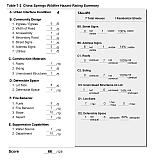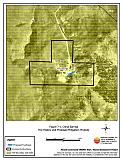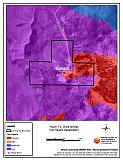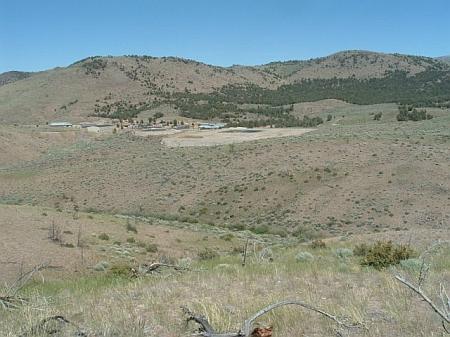7.0 China Springs
7.1 Hazard and Risk Assessment
China Springs is located in central Douglas County, west of US Highway 395, and approximately seven miles south of Gardnerville, Nevada. The community is located along China Springs Road 2.3 miles south of US Highway 395. The China Springs Youth Camp is situated between several hills with different aspects. An average of sixty youth and adult workers live at the China Springs Youth Camp year-round. The Carson Valley Trap and Sporting Clay facility is located north of the Youth Camp along China Springs Road. The risk and hazard assessment resulted in classifying China Springs in the High Hazard category (66 points). A summary of the factors that determine this hazard rating is included in Table 7-2. The primary factors affecting the High Hazard score were limited ingress and egress to the community and the potential for hazardous fire behavior due to topography and fuel loads.
7.1.1 Community Design
China Springs was characterized as a rural wildland-urban interface condition. The rural condition is described as scattered small clusters of structures exposed to wildland fuels, often with miles between the clusters (see Figure 7-1).
- Roads: China Springs has one paved road in and out of the community, China Springs Road. This road is between twenty and 24 feet wide and has a road grade less than five percent. The limited ingress and egress to the community could limit fire suppression and evacuation activities during a wildland fire.
- Signage: China Springs Road had visible street signs. Clear and visible residential addresses and street signs are important to aid firefighting personnel in locating homes during low visibility conditions that may occur during a wildland fire.
- Utilities: Above ground electrical and above ground propane tanks were the primary utilities serving China Springs. The above ground power line was properly cleared of trees beneath the lines.
7.1.2 Construction Materials
All of the structures in the community were built with heat or flame resistant siding materials, and all of the structures had fire resistant roofing materials such as steel or composition roofing.
7.1.3 Defensible Space
Most of the facilities at the Youth Camp had adequate defensible space, except for the girl’s dormitory.
7.1.4 Suppression Capabilities
Wildfire Protection Resources
The Ruhenstroth Volunteer Fire Department (Station 10) of the East Fork Fire Protection District provides wildfire and structure fire protection for China Springs. At the time of the assessment, the Ruhenstroth VFD listed eighteen volunteers on its roster (East Fork Fire Protection District website). See Tables 4-2 and 4-3 for more information on the typical fire suppression response for first-alarm wildland-urban interface fires in Douglas County. Appendix E lists the type and number of fire suppression vehicles located at each EFFPD and Douglas County VFD station.
Water Sources and Infrastructure
Water availability for fire suppression in China Springs includes gravity fed hydrants within 500 feet of structures in the China Springs Youth Camp. There is an emergency generator on site for the well that supplies a 50,000-gallon tank. There are possible helicopter dip sites at the Carson River, northwest of the community.
7.1.5 Factors Affecting Fire Behavior
Vegetation, dead and down fuels, and topographic features contribute to the potential fire hazard around wildland-urban interface communities. The fuel hazards were mapped for China Springs, and fuel hazard photos were taken to provide additional information for the vegetation type descriptions (see Figures 7-2 and 7-3).
China Springs is situated amongst hills with all aspects. Slopes vary from five to thirty percent and the predominant wind directions are from the south and west.
Three major fuel types were identified near the China Springs community including cheatgrass burned areas, unburned pinyon/juniper, and unburned sagebrush/rabbitbrush. The Indian Creek II fire in 1984 decreased the fuel density compared to the unburned areas. The dominant species in the burned areas includes big sagebrush, rabbitbrush, bitterbrush, bottlebrush squirreltail, crested wheatgrass, and cheatgrass. Occasional pinyon and juniper trees were noted to be scattered throughout the burn. The fuel hazard was classified as low and the fuel load was estimated at less than one ton per acre.
Closed-canopy singleleaf pinyon and Utah juniper trees with a sparse understory of big sagebrush, bitterbrush, bottlebrush squirreltail, and cheatgrass characterize unburned islands of vegetation around the Youth Camp. The fuel density was heavy in the area surrounding the residences, estimated at ten to twenty tons per acre and was rated an extreme fuel hazard.
Unburned sagebrush areas include big sagebrush, low sagebrush, bitterbrush, rabbitbrush, and horsebrush. Shrubs were generally six inches to two feet tall and spaced one to three feet apart. Dominant grass species include bottlebrush squirreltail, Indian ricegrass, Sandberg bluegrass, and Thurber’s needlegrass. The fuel load was estimated to be two to three tons per acre and considered a moderate fuel hazard.
7.1.6 Fire Behavior Worst Case Scenario
The worst-case scenario for China Springs would likely occur in late afternoon on a high hazard day during a dry lightning storm with numerous ignitions in the hills surrounding the facility. An ignition southeast of the community could rapidly spread through the dense pockets of unburned pinyon and juniper vegetation to the Youth Camp. Downslope and erratic winds from the east or southeast would exacerbate the situation. The scenario would be worse if mutual aid resources were unavailable due to assignment of an emergency situation elsewhere. If a wildfire were to block China Springs Road, evacuation and fire suppression could be greatly inhibited.
7.1.7 Ignition Risk Assessment
China Springs has a high ignition risk rating due in part to the large number of fire ignitions that have occurred in the last twenty years around the community. There is an extensive fire history for the community and adjacent areas (see Figure 3-2).
7.2 Risk and Hazard Reduction Recommendations
The China Springs risk and hazard reduction recommendations address the primary concern regarding protection of existing and future development in the wildland-urban interface area. Other recommendations pertain to community coordination and public education efforts that could be undertaken to enhance fire safety in China Springs.
7.2.1 Defensible Space Treatments
Defensible space treatments are an essential first line of defense for residential structures. Significantly reducing or removing vegetation within a prescribed distance from structures (minimum of 100 to 200 feet depending upon slope) reduces fire intensity and improves firefighter and homeowner chances for successfully defending a structure against an oncoming wildfire.
China Springs Youth Camp Nevada State Lands Division Recommendation
- Remove, reduce, and replace vegetation around Youth Camp structures according to the guidelines in Appendix D. This area should be kept:
- Lean: There are only small amounts of flammable vegetation,
- Clean: There is no accumulation of dead vegetation or other flammable debris,
- Green: Existing plants are healthy and green during the fire season.
7.2.2 Fuel Reduction Treatments
Fuel reduction treatments are applied on a larger scale than defensible space treatments. By permanently changing the fuel structure over large blocks of land to one of lower volume or reduced flammability (a fuel reduction treatment), the expected result in the event of a catastrophic wildfire would be one of reduced capacity for uncontrolled spread through the treatment area.
China Springs Youth Camp Nevada State Lands Division Recommendation
- Construct and maintain a 200-foot wide fuelbreak south of the girl’s dormitory at the China Springs Youth Camp for a distance of 500 feet. Thin pinyon and juniper trees to a maximum density of 25 trees per acre. Limb branches of remaining trees six feet from the ground or no more than one-third the height of the tree. Remove all shrubs within ten feet of tree canopies and thin brush such that canopies are spaced twice the height of the shrubs (see Figure 7-1).
7.3 Summary of Recommendations
| Involved Party | Recommended Treatment | Recommendation Description |
|---|---|---|
| China Springs Youth Camp Nevada Division of State Lands |
Defensible Space | Remove, reduce, and replace vegetation around structures according to the defensible space guidelines in Appendix D. |
| Fuels Reduction | Construct and maintain a 200-foot wide fuelbreak south of the girl’s dormitory at the China Springs Youth Camp for a distance of 500 feet. |
Table 7-2China Springs Wildfire Hazard Assessment Summary Sheet |
 |
Figure 7-1 |
 |
Figure 7-2China Springs Fuel Hazard Classification |
 |
Figure 7-3. China Springs Fuel Hazard Photo Points
Photo Point 1. China Springs Fuel Hazard Photo Point. 4299927N, 02688430E, 75°NE. Thethree predominant vegetation types around China Springs includes sagebrush, pinyon and juniper, and one burned area dominated by sagebrush and cheatgrass. Fuel loads in the burned sagebrush areas are less than one ton per acre and considered a low fuel hazard. Fuel loads in the unburned sagebrush were estimated to be between two and three tons per acre and considered to be a moderate fuel hazard. Fuel loads in the pinyon and juniper areas range between ten and twenty tons per acre and are considered an extreme fuelhazard.

